How to Prepare for Spray On Insulation
The prep work ahead of a sprayed insulation job is an important step. It’s how we protect the job site from overspray. It’s also how we ensure we leave the site better than when we started a job. When you contract with KC Spray Foam for your spray on insulation needs, this step is included in our price quote. We come in and cover all windows, doors, showers, tubs and other surfaces that need to be protected with plastic sheeting. With experience we have learned certain ways to cover efficiently. Leaving this work to us also helps avoid any questions that could arise. If the customer does the prep work and overspray gets on a window, it’s more complicated to determine who is responsible.
Our policy is, if you don’t want overspray on it, it must be covered or removed from the space. Keep in mind, our sales people consider all of this during the bidding process. If there is anything you can remove from the building in advance of the project, it can save you money. This also guarantees your things are moved and stored just the way you want. Building components that cannot be removed, such as prefinished floors, can increase the installation cost because they must be protected.
Where Foam Insulation Fits in the Process
It’s important to make sure all the HVAC, plumbing and electrical work is complete before we get there. For our installation to be the most energy efficient and cost effective, these items need to be in place. We are no different than most subcontractors, if we have to pay our crew to wait on other contractors to complete work on the job site, or if we need to make additional trips, it ends up costing more money.
If at all possible, do not have drywall delivered until your Kansas City spray foam job is complete. Drywall is difficult to work around, making it one more thing to be protected. It can also be a safety hazard for our foam insulation applicators maneuvering on the site.
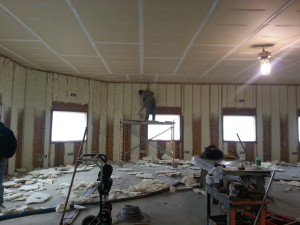 Keep in mind, we will be dragging a hose that is approximately 3 inches in diameter around the work site. We will also be trimming foam, which will result in foam dropping to the floor surface. We realize we’re working on a construction site, but good housekeeping benefits all who work on the job. You don’t want to pay us to clean up after other contractors on the job – each contractor should do their part. When taking bids from all spray on insulation contractors (or other contractors for your site), make sure they understand the job site should be left neat and clean every night at quitting time. The state in which a contractor leaves a job site at the end of the day says a lot about what kind of work they are doing. This is something to pay attention to throughout the building process!
Keep in mind, we will be dragging a hose that is approximately 3 inches in diameter around the work site. We will also be trimming foam, which will result in foam dropping to the floor surface. We realize we’re working on a construction site, but good housekeeping benefits all who work on the job. You don’t want to pay us to clean up after other contractors on the job – each contractor should do their part. When taking bids from all spray on insulation contractors (or other contractors for your site), make sure they understand the job site should be left neat and clean every night at quitting time. The state in which a contractor leaves a job site at the end of the day says a lot about what kind of work they are doing. This is something to pay attention to throughout the building process!
Access Points Prior to Foam Insulation
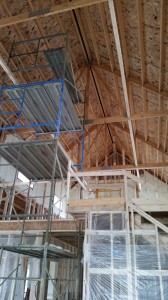 We need clear vertical access to all areas where we will be installing spray foam insulation. We can’t work safely from extension ladders while dragging a heavy 3-inch hose. Most of the time we don’t use ladder access to spray foam. We use scaffolding to provide job-specific access. This is actually a lot faster and safer!
We need clear vertical access to all areas where we will be installing spray foam insulation. We can’t work safely from extension ladders while dragging a heavy 3-inch hose. Most of the time we don’t use ladder access to spray foam. We use scaffolding to provide job-specific access. This is actually a lot faster and safer!
We also need proper access to the job site. This means snow needs to be removed prior to our arrival in cold months. Or, if the site is muddy and doesn’t have some kind of gravel installed, we won’t be able to get our truck into place. Dumpsters, building materials or other equipment that prevents access also need to be removed so we can use our equipment accurately.
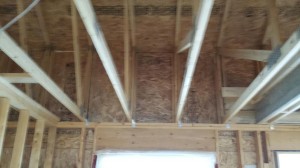 Proper backing must be installed. This means areas like soffits, knee walls and common walls into garages need sheeting or backing before we can begin. We have to have something to spray our foam insulation to! When backing, ensure the joints are tight. Spray foam will find all cracks and holes. When the backing isn’t secure, foam will come out the other side – potentially on to siding, windows or a shiny car! Unfortunately, when this happens it does not come off easily. Here’s a tip: use canned spray foam to seal large joints, cracks or holes before we begin.
Proper backing must be installed. This means areas like soffits, knee walls and common walls into garages need sheeting or backing before we can begin. We have to have something to spray our foam insulation to! When backing, ensure the joints are tight. Spray foam will find all cracks and holes. When the backing isn’t secure, foam will come out the other side – potentially on to siding, windows or a shiny car! Unfortunately, when this happens it does not come off easily. Here’s a tip: use canned spray foam to seal large joints, cracks or holes before we begin.
Along the same lines, all wiring, plumbing, duct work, etc., needs to be properly fastened. When the sprayed insulation expands, it will bring wiring out with it. The problem comes when we go to trim the foam – we can’t see the displaced wiring and it may get cut accidentally. This doesn’t make anyone happy and can be easily avoided. Ask your electrician to staple wires well to keep things in place.
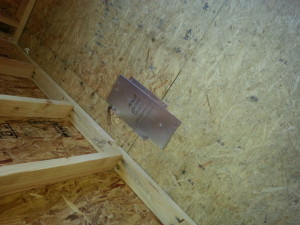 To protect our installers and your site, HVAC vents in the floors should be covered before we start. As you can imagine, these holes pose a safety hazard for workers to fall in or roll a scaffold over. Covering vents also protects them from dirt or debris that will fall on the job site. Some contractors use scrap sheeting screwed down over them to keep debris – like spray foam trimmings – from entering the duct work.
To protect our installers and your site, HVAC vents in the floors should be covered before we start. As you can imagine, these holes pose a safety hazard for workers to fall in or roll a scaffold over. Covering vents also protects them from dirt or debris that will fall on the job site. Some contractors use scrap sheeting screwed down over them to keep debris – like spray foam trimmings – from entering the duct work.
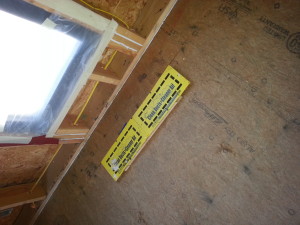 Stairwells and other open areas also pose safety hazards to contractors. For this reason, they must have proper safety railing installed to OSHA specifications. Providing a safe, compliant site helps alleviate the chances for a work-related injury and related liability.
Stairwells and other open areas also pose safety hazards to contractors. For this reason, they must have proper safety railing installed to OSHA specifications. Providing a safe, compliant site helps alleviate the chances for a work-related injury and related liability.
Following these steps helps us keep costs down, and more importantly helps keep everyone safe on the job site. If you have questions, be sure to ask us – we are happy to provide insight on how you can prepare your site to be as safe as possible!
About the author
Mark grew up in Winterset, Iowa: the birthplace of John Wayne and the home of Madison County Covered Bridges. He lived on a small acreage where they raised cattle, sheep, and chickens. During his youth, he raised and showed cattle with the local 4H program.
Mark’s first paying job was working at the local lumberyard after school and on weekends. After he graduated from Winterset High School he pursued the agricultural field by working on a large farming operation eventually working his way up to the manger position and partner. He also had a long career in the transportation industry.
Mark continues to own and oversee the operations of Iowa Spray Foam in addition to KC Spray Foam & Coatings.
Mark resides in Lee’s Summit, MO with his wife Tina and three of their four children. Their oldest lives and works in the Kansas City area as well.